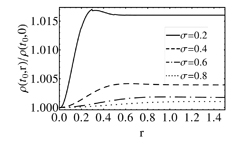Primordial curvature perturbations and the cosmological constant (Vol. 45 No.5-6)

The standard cosmological model is based on the assumption that the Universe is homogeneous and isotropic on a sufficiently large scale. Inflation can give a natural explanation to this large scale homogeneity, through a sufficiently long period of exponential expansion of the Universe, but it also predicts the existence of perturbations of the metric, which are in good agreement with the observed anisotropy of the cosmic microwave background radiation or the large structure of the spatial distribution of galaxies.
This is the motivation to study the effects on the luminosity distance of a local inhomogeneity seeded by primordial curvature perturbations of the type predicted by the inflationary scenario. We find that a local underdensity originated from one, two or three standard deviations peaks of the primordial curvature perturbations field can induce corrections to the value of a cosmological constant of the order of 0.6%, 1%, 1.5%, respectively.
Our results can be considered an upper bound for the effect of the monopole component of the local non-linear structure which can arise from primordial curvature perturbations and requires a fully non-perturbative relativistic treatment.
A. E. Romano, S. Sanes Negrete, M. Sasaki and A. A. Starobinsky, “Non-perturbative effects of primordial curvature perturbations on the apparent value of a cosmological constant”, EPL, 106, 69002 (2014)
[Abstract]







